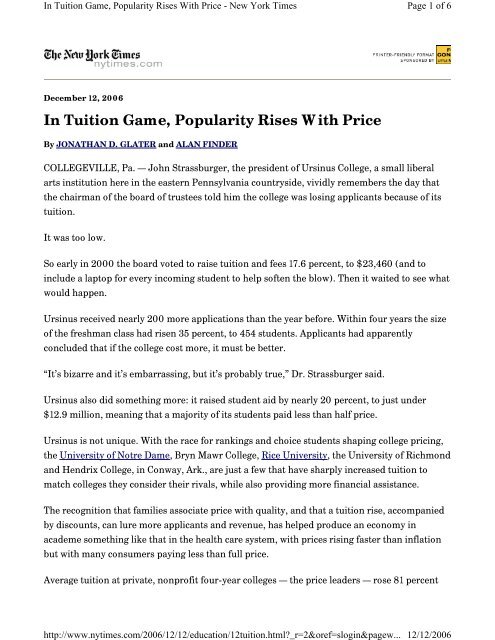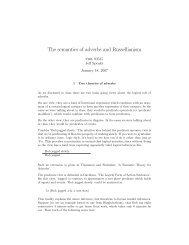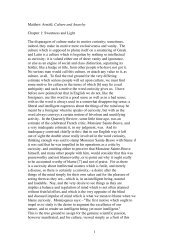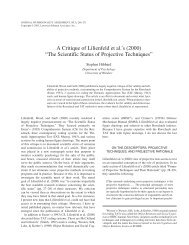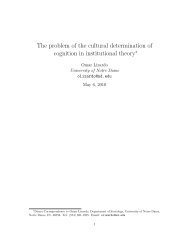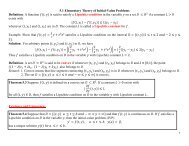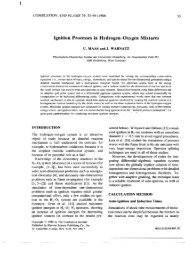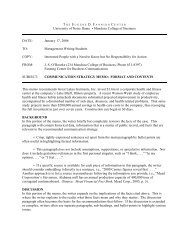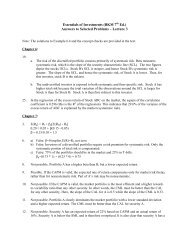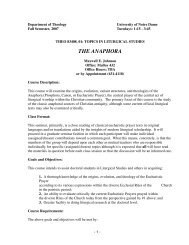In Tuition Game Popularity Rises With Price.pdf - University of Notre ...
In Tuition Game Popularity Rises With Price.pdf - University of Notre ...
In Tuition Game Popularity Rises With Price.pdf - University of Notre ...
You also want an ePaper? Increase the reach of your titles
YUMPU automatically turns print PDFs into web optimized ePapers that Google loves.
<strong>In</strong> <strong>Tuition</strong> <strong>Game</strong>, <strong>Popularity</strong> <strong>Rises</strong> <strong>With</strong> <strong>Price</strong> - New York Times<br />
December 12, 2006<br />
<strong>In</strong> <strong>Tuition</strong> <strong>Game</strong>, <strong>Popularity</strong> <strong>Rises</strong> <strong>With</strong> <strong>Price</strong><br />
By JONATHAN D. GLATER and ALAN FINDER<br />
COLLEGEVILLE, Pa. — John Strassburger, the president <strong>of</strong> Ursinus College, a small liberal<br />
arts institution here in the eastern Pennsylvania countryside, vividly remembers the day that<br />
the chairman <strong>of</strong> the board <strong>of</strong> trustees told him the college was losing applicants because <strong>of</strong> its<br />
tuition.<br />
It was too low.<br />
So early in 2000 the board voted to raise tuition and fees 17.6 percent, to $23,460 (and to<br />
include a laptop for every incoming student to help s<strong>of</strong>ten the blow). Then it waited to see what<br />
would happen.<br />
Ursinus received nearly 200 more applications than the year before. <strong>With</strong>in four years the size<br />
<strong>of</strong> the freshman class had risen 35 percent, to 454 students. Applicants had apparently<br />
concluded that if the college cost more, it must be better.<br />
“It’s bizarre and it’s embarrassing, but it’s probably true,” Dr. Strassburger said.<br />
Ursinus also did something more: it raised student aid by nearly 20 percent, to just under<br />
$12.9 million, meaning that a majority <strong>of</strong> its students paid less than half price.<br />
Ursinus is not unique. <strong>With</strong> the race for rankings and choice students shaping college pricing,<br />
the <strong>University</strong> <strong>of</strong> <strong>Notre</strong> Dame, Bryn Mawr College, Rice <strong>University</strong>, the <strong>University</strong> <strong>of</strong> Richmond<br />
and Hendrix College, in Conway, Ark., are just a few that have sharply increased tuition to<br />
match colleges they consider their rivals, while also providing more financial assistance.<br />
The recognition that families associate price with quality, and that a tuition rise, accompanied<br />
by discounts, can lure more applicants and revenue, has helped produce an economy in<br />
academe something like that in the health care system, with prices rising faster than inflation<br />
but with many consumers paying less than full price.<br />
Page 1 <strong>of</strong> 6<br />
Average tuition at private, nonpr<strong>of</strong>it four-year colleges — the price leaders — rose 81 percent<br />
http://www.nytimes.com/2006/12/12/education/12tuition.html?_r=2&oref=slogin&pagew...<br />
12/12/2006
<strong>In</strong> <strong>Tuition</strong> <strong>Game</strong>, <strong>Popularity</strong> <strong>Rises</strong> <strong>With</strong> <strong>Price</strong> - New York Times<br />
from 1993 to 2004 , more than double the inflation rate, according to the College Board, while<br />
campus-based financial aid rose 135 percent.<br />
The average cost <strong>of</strong> tuition, fees, room and board at those colleges is now $30,367. Many<br />
charge much more; at George Washington <strong>University</strong>, the sum is more than $49,000.<br />
But aid is now so extensive that more than 73 percent <strong>of</strong> undergraduates attending private<br />
four-year institutions received it in the school year that ended in 2004, not even counting<br />
loans.<br />
“We can cushion the sticker shock,” said Amy Gutmann, president <strong>of</strong> the <strong>University</strong> <strong>of</strong><br />
Pennsylvania, which distributes aid on the basis <strong>of</strong> financial need. “We focus on both middleincome<br />
and low-income families.”<br />
So net prices vary widely on a given campus. On some, as many as 90 percent <strong>of</strong> students<br />
receive support, primarily from the college itself or the federal government.<br />
Page 2 <strong>of</strong> 6<br />
And financial need is not the only basis for it. Many colleges, competing for the students with<br />
high grades and standardized test scores that help a college rise in rankings guides, <strong>of</strong>fer merit<br />
aid ranging from a few thousand dollars to a full scholarship.<br />
But <strong>of</strong>ficials <strong>of</strong> private colleges and universities say they fear that unless other steps are taken,<br />
the middle and upper middle class could ultimately be squeezed out.<br />
“Eventually, if we’re going to keep raising tuition at rates much more than the increase in<br />
family incomes, then something has to be done to make the places more accessible to the<br />
middle class,” said Ronald G. Ehrenberg, director <strong>of</strong> the Cornell Higher Education Research<br />
<strong>In</strong>stitute.<br />
As it is, some students may not even apply to private colleges, scared away from the start by<br />
tuition and unaware <strong>of</strong> the available discounts. After all, tuition and fees at public colleges and<br />
universities — though growing recently at a faster pace than those at private institutions —<br />
remain vastly lower, at an average <strong>of</strong> $5,836, the College Board says.<br />
It can be argued that everyone studying at a private liberal arts college is getting a discount. At<br />
institution after institution, <strong>of</strong>ficials say they <strong>of</strong>fer an education costing tens <strong>of</strong> thousands <strong>of</strong><br />
dollars more than even the college’s “sticker price.”<br />
Take Swarthmore, the elite college half an hour’s drive from Ursinus. <strong>With</strong> an annual budget <strong>of</strong><br />
$106 million to educate just under 1,500 undergraduates, Swarthmore spends about $73,690 a<br />
http://www.nytimes.com/2006/12/12/education/12tuition.html?_r=2&oref=slogin&pagew...<br />
12/12/2006
<strong>In</strong> <strong>Tuition</strong> <strong>Game</strong>, <strong>Popularity</strong> <strong>Rises</strong> <strong>With</strong> <strong>Price</strong> - New York Times<br />
student. But its tuition, room, board and fees in the last academic year were little more than<br />
$41,000.<br />
“The half <strong>of</strong> our student body whose families are paying the full sticker price are paying<br />
$41,000 for something that costs $73,000,” said Suzanne P. Welsh, the treasurer. “So they’re<br />
getting a great discount.”<br />
The other students receive a bigger subsidy: on average, aid totaling more than $28,500, most<br />
<strong>of</strong> it from the college itself. (Swarthmore limits its aid to students with financial need, but that<br />
can mean those from families earning $150,000 a year if, for instance, there are circumstances<br />
like having multiple children in college.)<br />
What makes it all work is Swarthmore’s $1.3 billion endowment, which throws <strong>of</strong>f enough<br />
income to cover 43 percent <strong>of</strong> the operating budget.<br />
The biggest expenditure at liberal arts colleges is for salaries and benefits. <strong>With</strong> competition for<br />
big-name pr<strong>of</strong>essors becoming more intense, faculty salaries have increased. So has the pay <strong>of</strong><br />
college and university presidents, more than 100 <strong>of</strong> whom now receive at least $500,000 a<br />
year.<br />
Then there are the amenities sought by students: c<strong>of</strong>fee bars, lavish new dormitories, state-<strong>of</strong>the-art<br />
science laboratories and fitness centers.<br />
“You’re trying to create the best educational experience for your students, and that costs<br />
money,” said Tom Tritton, president <strong>of</strong> Haverford College. “I sometimes say to parents, ‘I can<br />
make it cheaper if you want.’ ”<br />
Still, none <strong>of</strong> this explains why colleges like Swarthmore and Ursinus — with different studentfaculty<br />
ratios, endowments and reputations — end up with tuition and fees only a few hundred<br />
dollars apart, or less. Or why Harvard’s tuition and fees, at $33,709, are virtually the same as<br />
theirs.<br />
One big reason is that institutions <strong>of</strong> higher learning watch one another.<br />
<strong>In</strong> November, the finance committee <strong>of</strong> Swarthmore’s board <strong>of</strong> managers gathered at a<br />
Manhattan law firm and pored over a chart <strong>of</strong> tuition, room and board at more than 30<br />
prestigious colleges and universities. They were pleased to see that Swarthmore was charging<br />
somewhat less than most <strong>of</strong> its competitors.<br />
That kind <strong>of</strong> scrutiny led Bryn Mawr to a contrary sentiment, causing the college to raise<br />
http://www.nytimes.com/2006/12/12/education/12tuition.html?_r=2&oref=slogin&pagew...<br />
Page 3 <strong>of</strong> 6<br />
12/12/2006
<strong>In</strong> <strong>Tuition</strong> <strong>Game</strong>, <strong>Popularity</strong> <strong>Rises</strong> <strong>With</strong> <strong>Price</strong> - New York Times<br />
tuition and fees this year by about 9 percent, their biggest jump in several years. Bryn Mawr<br />
<strong>of</strong>ficials say they made the decision after their research showed that the college charged less<br />
than its rivals and awarded more aid. The <strong>of</strong>ficials concluded that raising tuition would not<br />
deter applicants, because prospective students already assumed that Bryn Mawr cost the same<br />
as comparable colleges.<br />
“The question was, Does that make sense?” said John Griffith, Bryn Mawr’s treasurer and chief<br />
financial <strong>of</strong>ficer. “Have we benefited at all from being the low price point? And the answer was<br />
no.”<br />
Some <strong>of</strong> the nation’s bigger institutions have also found an incentive to raise prices. As part <strong>of</strong><br />
an effort to improve its academic <strong>of</strong>ferings and transcend its renown for football, the <strong>University</strong><br />
<strong>of</strong> <strong>Notre</strong> Dame has raised tuition and fees by an inflation-adjusted 27 percent since 1999, to<br />
$32,900. <strong>In</strong> setting tuition, <strong>Notre</strong> Dame watches 20 other colleges and universities, including<br />
the <strong>University</strong> <strong>of</strong> Chicago, Emory and Vanderbilt.<br />
“We’re setting it by our competitors,” said the Rev. John I. Jenkins, the institution’s president.<br />
But <strong>Notre</strong> Dame’s financial aid has increased even more over the same period, with<br />
undergraduate scholarships up 107 percent after adjustment for inflation. This year the<br />
university is distributing $68 million.<br />
Facing stiff competition, Hendrix College, a small liberal arts institution in Conway, Ark.,<br />
decided two years ago to bolster its academic <strong>of</strong>ferings, promising students at least three<br />
hands-on experiences outside the classroom, including research, internships and service<br />
projects. It also raised tuition and fees 29 percent, to $21,636. Most <strong>of</strong> the increase went back<br />
to students as aid.<br />
As a result, 409 students enrolled in the freshman class this year, a 37 percent increase.<br />
Page 4 <strong>of</strong> 6<br />
“What worked was the buzz,” said J. Timothy Cloyd, the Hendrix president. “Students saw that<br />
they were going to get an experience that had value, and the price positioning conveyed to<br />
them the value <strong>of</strong> the experience.”<br />
Other colleges have tried the opposite. Muskingum College in New Concord, Ohio, cut tuition<br />
and fees drastically in 1996, to $10,285 from $14,240.<br />
“We believed that if we lowered tuition, we would open access to the middle class” and “that we<br />
would continue to serve the higher socioeconomic-background students by becoming a best-<br />
http://www.nytimes.com/2006/12/12/education/12tuition.html?_r=2&oref=slogin&pagew...<br />
12/12/2006
<strong>In</strong> <strong>Tuition</strong> <strong>Game</strong>, <strong>Popularity</strong> <strong>Rises</strong> <strong>With</strong> <strong>Price</strong> - New York Times<br />
buy institution,” said Anne C. Steele, Muskingum’s president.<br />
Revenue increased, with enrollment <strong>of</strong> more students who could pay full price. Muskingum has<br />
also grown, to 1,600 undergraduates from about 1,000.<br />
Yet the same strategy proved disastrous for North Carolina Wesleyan College. Ten years ago<br />
that college cut tuition and fees by 22 percent, to $7,150. But it attracted fewer wealthy<br />
applicants and more poor ones, who needed more aid even as the revenue generated from<br />
tuition declined.<br />
“It didn’t work out the way it had been hoped,” said Ian David Campbell Newbould, the<br />
college’s president. “People don’t want cheap.”<br />
But they do apparently want a deal, or at least the perception <strong>of</strong> one. Lucie Lapovsky, a<br />
consultant who was once president <strong>of</strong> Mercy College in New York, conducted a study asking<br />
students to choose between a college charging $20,000 and <strong>of</strong>fering no aid, and one charging<br />
$30,000 and <strong>of</strong>fering a $10,000 scholarship. Students chose the pricier option.<br />
“Americans seem to like college on sale,” Dr. Lapovsky said.<br />
Many administrators say that without raising prices, they could not maintain or expand<br />
economic diversity among the student body. <strong>In</strong> other words, making college more expensive for<br />
some enables less well <strong>of</strong>f students to go.<br />
But Brian Zucker, president <strong>of</strong> the Human Capital Research Corporation, a consulting firm that<br />
works with colleges, is suspicious <strong>of</strong> that argument, particularly given the growth <strong>of</strong> merit aid.<br />
He points out that many middle-class students borrow tens <strong>of</strong> thousands <strong>of</strong> dollars to attend<br />
liberal arts colleges and that at some, they may be helping defray the cost <strong>of</strong> a merit scholarship<br />
to a wealthier applicant.<br />
“It’s not a given that the subsidy is going in any predetermined direction,” Mr. Zucker said.<br />
“We don’t know.”<br />
TOMORROW: Students, recent graduates, college presidents and others talk about whether<br />
they think a private college education is worth its cost.<br />
Jonathan D. Glater reported from Collegeville, Pa., and Alan Finder from New York.<br />
Copyright 2006 The New York Times Company<br />
http://www.nytimes.com/2006/12/12/education/12tuition.html?_r=2&oref=slogin&pagew...<br />
Page 5 <strong>of</strong> 6<br />
12/12/2006
<strong>In</strong> <strong>Tuition</strong> <strong>Game</strong>, <strong>Popularity</strong> <strong>Rises</strong> <strong>With</strong> <strong>Price</strong> - New York Times<br />
Page 6 <strong>of</strong> 6<br />
Privacy Policy Search Corrections RSS First Look Help Contact Us Work for Us Site Map<br />
http://www.nytimes.com/2006/12/12/education/12tuition.html?_r=2&oref=slogin&pagew...<br />
12/12/2006


